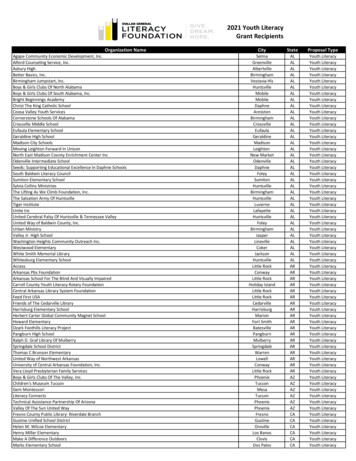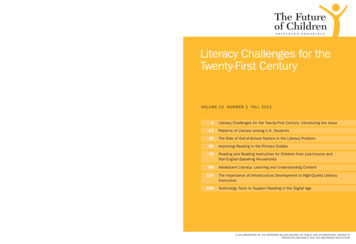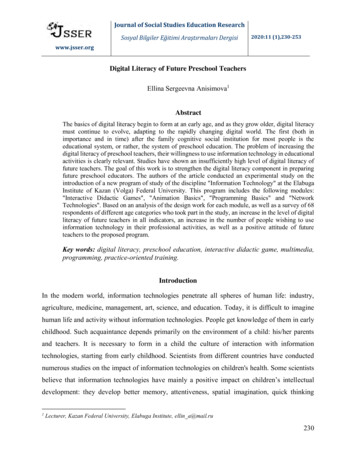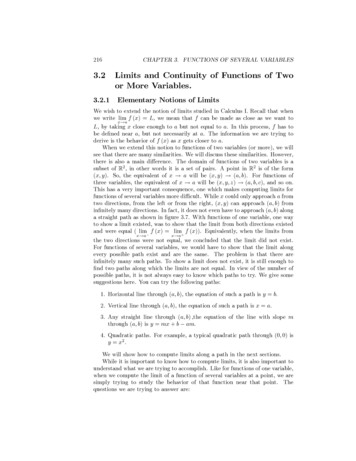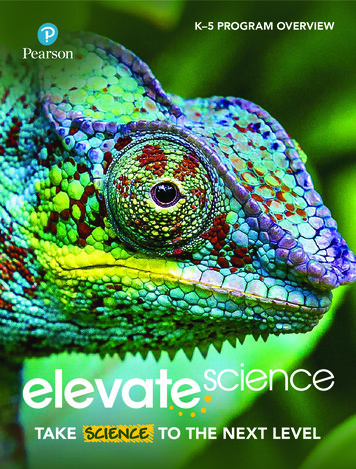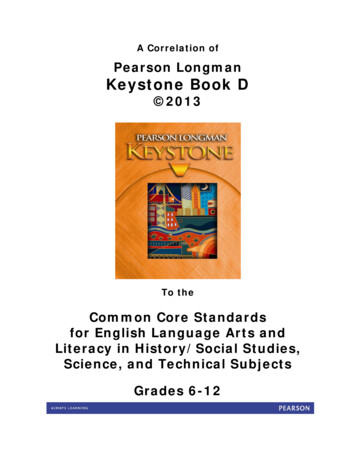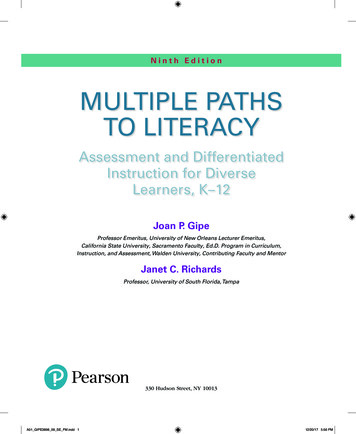
Transcription
Ninth EditionMULTIPLE PATHSTO LITERACYAssessment and Differentiated Instruction for DiverseLearners, K–12Joan P. GipeProfessor Emeritus, University of New Orleans Lecturer Emeritus,California State University, Sacramento Faculty, Ed.D. Program in Curriculum,Instruction, and Assessment, Walden University, Contributing Faculty and MentorJanet C. RichardsProfessor, University of South Florida, Tampa330 Hudson Street, NY 10013A01 GIPE3898 09 SE FM.indd 112/20/17 5:56 PM
Director and Publisher: Kevin DavisExecutive Portfolio Manager: Drew BennettManaging Content Producer: Megan MoffoContent Producer: Yagnesh JaniPortfolio Management Assistant: Maria Felibertyand Casey CoriellDevelopment Editor: Jill RossExecutive Product Marketing Manager: Christopher BarryExecutive Field Marketing Manager: Krista ClarkManufacturing Buyer: Deidra SmithCover Design: Studio MontageCover Art: getty images FatCameraMedia Producer: Lauren CarlsonEditorial Production and Composition Services:SPi Global, Inc.Editorial Project Manager: Mirasol Dante, SPi GlobalFull-Service Project Manager: Subash RajuText Font: ITC Garamond Std, 10/12Credits and acknowledgments borrowed from other sources and reproduced, with permission, in this textbook appear on appropriate page within textor on this page.Additional Text Credits: p. 8: Insights with Implications for the Early Literacy Learning Environment: Based on Emerging literacy: New p erspectives.In Emerging literacy: Young children learn to read and write, eds. D. Strickland and L. Morrow, by W. Teale and E. Sulzby 1989 by the I nternational Reading Association.” p. 60: Developmental Stages of English Language Development: Information from Into English! by Josefina Villamil Tinajeroand Alfredo Schifini, 1997, published by Hampton-Brown Books. p. 95: Learning Preferences Assessment Menu: Adapted from Multiple Intelligence Approaches to Assessment, 1994 Zephyr Press, Tucson, Arizona. pp. 108–109: “Characters: What else can you tell me about (name ofcharacter(s) Where and when did the story take place?’’ (114 words): Based on Weaver, C. (2002). Reading process and practice (3rd ed.). Portsmouth,NH: Heinemann; p. 111: Level 1 Passage Scored and Analyzed as a Running Record: Based on Flynt/Cooter, Reading Inventory for the Classroom.p. 140: CC Connection 6.1: Copyright 2010. National Governors Association Center for Best Practices and Council of Chief State School O fficers.All rights reserved. p. 158: CC Connection: 7.1: Copyright 2010. National Governors Association Center for Best Practices and Council ofChief State School Officers. All rights reserved. p. 171: Tips for Teachers about Young Learners’ Visual Art: Some ideas suggested by Lynch 2016.p. 180: CC Connection 8.1: Copyright 2010. National Governors Association Center for Best Practices and Council of Chief State School Officers. Allrights reserved. p. 211: CC Connection 9.1: Copyright 2010. National Governors Association Center for Best Practices and Council of Chief State School Officers. All rights reserved. p. 254: CC Connection 10.1: Copyright 2010. National Governors Association Center for Best Practices and Council ofChief State School Officers. All rights reserved. p. 279: Figure 10.16 Word Pyramid (Sprenger, 2017): Based on Sprenger, 2017. p. 301: CC C onnection11.1: Copyright 2010. National Governors Association Center for Best Practices and Council of Chief State School Officers. All rights reserved.p. 310: Teaching Active Comprehension: Based on “A Story of a Hare and a Fox. p. 317: Example of a Concept Guide: Based on Concept Guide for“Auto Wreck.” p. 328: CC Connection 12.1: Copyright 2010. National Governors Association Center for Best Practices and Council of Chief State SchoolOfficers. All rights reserved. p. 354: CC Connection 13.1: Copyright 2010. National Governors Association Center for Best Practices and Council ofChief State School Officers. All rights reserved. p. 379: Predict, Observe, Explain Sequence: Based on Haysom & Bowen, 2010, p. x–xi.p. 390: CC Connection 14.1: Copyright 2010. National Governors Association Center for Best Practices and Council of Chief State School Officers.All rights reserved.Photo in Spotlight on English Learners feature: Jaren Wicklund/Fotolia; photo in Vignette feature: Goodluz/Fotolia; photo in Arts Connection feature:Africa Studio/Fotolia; photo on page v: Courtesy of Charles A. Duffy.Copyright 2019, 2014, 2010, 2006 Pearson Education, Inc. All rights reserved. Manufactured in the United States of America. This p ublication isprotected by Copyright, and permission should be obtained from the publisher prior to any prohibited r eproduction, storage in a retrieval system, ortransmission in any form or by any means, electronic, mechanical, photocopying, recording, or likewise. To obtain permission(s) to use material fromthis work, please submit a written request to Pearson Education, Inc., Permissions Department, One Lake Street, Upper Saddle River, NJ 07458, or youmay fax your request to 201-236-3290.Many of the designations by manufacturers and seller to distinguish their products are claimed as trademarks. Where those designations appear in thisbook, and the publisher was aware of a trademark claim, the designations have been printed in initial caps or all caps.Library of Congress Cataloging-in-Publication DataNames: Gipe, Joan P., author. Richards, Janet C., author.Title: Multiple paths to literacy : assessment and differentiated instructionfor diverse learners, K-12 / Joan P. Gipe, Professor Emeritus, Universityof New Orleans Lecturer Emeritus, California State University, SacramentoFaculty, Ed.D. Program in Curriculum, Instruction, and Assessment, WaldenUniversity, Janet C. Richards, Professor, University of South Florida,Tampa.Description: Ninth Edition. Boston : Pearson, [2017]Identifiers: LCCN 2017051363 ISBN 9780134683898 ISBN 0134683897Subjects: LCSH: Reading–Remedial teaching.Classification: LCC LB1050.5 .G545 2017 DDC 372.43–dc23 LC record available at https://lccn.loc.gov/2017051363117ISBN 10: 0-13-468389-7ISBN 13: 978-0-13-468389-8A01 GIPE3898 09 SE FM.indd 212/20/17 5:56 PM
As always, I dedicate this work to Charlie,my parents (miss you, Mom and Dad), and my loyal companion,Cocoa, who has survived another edition with me, her third.I dedicate this work to my husband, Paul, my two sons,my four grandchildren, and my great grandchild.Thanks also to my two daughters-in-law.A01 GIPE3898 09 SE FM.indd 312/20/17 5:56 PM
A01 GIPE3898 09 SE FM.indd 412/20/17 5:56 PM
About the AuthorsJoan P. Gipe is Research Professor Emeritus from the University ofNew Orleans and Lecturer Emeritus from California State University,Sacramento. She is currently engaged in online mentoring for WaldenUniversity’s EdD program. After g raduating from the University ofKentucky with a BA and an MA in education, and Purdue Universitywith a PhD emphasizing reading education, Joan spent many yearsworking with learners of all ages: in Kentucky as a reading specialist,in Indiana as a fifth-grade teacher, and in several university contextsas faculty, supervisor of student teachers, department chairperson,coordinator for teaching enhancement, university/school liaison forprofessional development schools, coordinator of field-based teachereducation cohorts, and now mentor for numerous doctoral studentsengaged in research toward the Ed.D. Many publications, includingthis text, share with the professional community what was learned during this career.Joan now resides in the charming town of Healdsburg, California, nestled in the heartof Sonoma County’s Wine Country. She savors life there with her husband and herfour-legged companion, Cocoa, a field spaniel, who earned an Honorable Mention inSonoma County’s Best in Show.Joan may be contacted at PO Box 1553, Healdsburg, CA 95448.E-mail joan.gipe@mail.waldenu.edu.Janet C. Richards received a BS degree in K-8 Teaching from New Jersey City University, an MA from Tulane University in Guidance and Counseling, and a PhDin Curriculum and Instruction with an emphasis in Literacy from the Universityof New Orleans. She taught grades K-6 in New Jersey, New York, North Carolina,New Orleans, and the Republic of Panama. She is a Professor of Literacy at theUniversity of South Florida, Tampa, where she teaches doctoral courses in writingand transdisciplinary texts, teaching, and research. She is also an affiliate facultymember in the Department of Educational Measurement at USF where she teachesPhD introductory and advanced qualitative research courses, Art-Based Research,and Writing as Inquiry. She serves as chair or methodologist on numerous PhDcommittees annually. She was selected as a Volunteer Literacy Scholar for the International Literacy Association’s “Reading and Writing for Critical Thinking” projectin which she worked with teachers and higher education faculty in developingnations, such as Azerbaijan, Estonia, Romania, and Hungary, and with indigenousMyanmar political refugees in jungle camps between Myanmar and Thailand. She servesas senior editor of Literacy Practice and Research, received the Organization of Literacy Teacher Educators’ 2016 Award for Scholarly Research, and was chosen as theLansdowne Invited Visiting Scholar at the University of Victoria, BC, Canada. She isthe author of numerous scholarly manuscripts. This volume is her 13th textbook. Shelives in Tampa, Florida, with her husband, brilliant little rescue dog, Jezzy, and twoclever rescue cats. She is the proud mother of David and Matthew; mother-in-law ofAllison and Missy; g randmother of Elizabeth, Madeline, Noah, and Joshua; and greatgrandmother of Jacob. She may be reached at JRichards@usf.edu.A01 GIPE3898 09 SE FM.indd 512/20/17 5:56 PM
Brief ContentsPart IFoundationsCHAPTER 1Fundamental Aspects of Literacy Learning 2CHAPTER 2The Analytic Process: Preparation for Differentiating Instruction andData-Driven Decision-Making 14CHAPTER 3Literacy Education of English Language Learners: Some LinguisticAspects of Theory and Practice 42CHAPTER 4Physical, Psychological, and Environmental Factors Affecting LiteracyDevelopment 64CHAPTER 5Literacy Assessment: Summative and Formative AssessmentsPart IIThe Major DomainsCHAPTER 6Early Literacy SkillsCHAPTER 7Supporting All Students’ Literacy Development through the ArtsCHAPTER 8The Reading-Writing Connection: Best Practices and StrategiesCHAPTER 9Word Recognition 208CHAPTER 10Reading VocabularyCHAPTER 11Reading Comprehension: An OverviewCHAPTER 12Comprehending Narrative TextCHAPTER 13Expository Text and Disciplinary LiteracyCHAPTER 14Study Skills and Test-Taking StrategiesAPPENDIXESAssessment Resources 433A01 GIPE3898 09 SE FM.indd 69213615617824628632435038412/20/17 5:56 PM
ContentsPrefacexvPart IFoundationsCHAPTER 1Fundamental Aspects of Literacy Learninglearning objectives Literacy Processes sIsIsIsIsIsvocabulary alerta Language Process 4a Cognitive Process 5a Psychological or Affective Processa Social/Cultural Process 6a Physiological Process 7an Emerging Process 7226Approaches to Literacy Instruction 8Two Major Goals of an Effective Literacy Program10Academic Literacy 10Recreational Literacy 11Summary 12Recommended WebsitesCHAPTER 213The Analytic Process: Preparation for Differentiating Instructionand Data-Driven Decision-Making 14learning objectives vocabulary alertJustification for The Analytic Process 1614Problems Associated with Assumptive Teaching 16The Analytic Process Paradigm and the RTI Framework17Analytic Teaching: Teaching for Democracy and Social JusticeThe Analytic Teacher1820Analyzing Components of Literacy Learning to Assist Differentiated InstructionLevels of Analysis and Correlative Diagnostic QuestionsBasic Steps in the Analytic Process222228Analysis of Literacy Behaviors: Diagnosis 28Generation of Possible Teaching Hypotheses 29Teaching 29Reexamination of Literacy Behaviors: Analyze 32From Teaching Hypotheses to Lesson Plans 32Distinguishing Teacher Objectives and Correlated Student Learning ObjectivesWriting Student Learning Objectives 35Learning Activities 37Summary 41Recommended WebsitesA01 GIPE3898 09 SE FM.indd 7344112/20/17 5:56 PM
viiiCONTENTSCHAPTER 3Literacy Education of English Language Learners: Some LinguisticAspects of Theory and Practice 42 Contributing Author: John G. Barnitz,Professor Emeritus, University of New Orleanslearning objectives vocabulary alertCommunicative Competence 44Some Linguistic Variations 4642Variations across Languages 46Variations within a Language 50Other Linguistic Variations 51Aspects of Second-Language Acquisition 52Some Linguistic-Related Principles for Literacy Education of Diverse Learners53Respect Differences in Languages and Dialects as Natural 54Use Methods That Bridge Cultural Background Knowledge and Whatever TextsAre Being Read 54Integrate Instruction on Language Structures and Skills within the Composingand Comprehending Process 54Use Authentic Materials from the Learner’s Community 55Access Learners’ Out-of-School Interests in the Community as Relevant to Literacyand Language Development 55Design Literature-Based Instruction for Developing Language Competence 56Use Technological and Other Communicative Arts to Facilitate Oral and WrittenLanguage Acquisition 56Facilitate Authentic, Functional Communication 57Base Literacy Assessment on Authentic Language and Literacy Tasks and Events 57Practice Ongoing, Continuous, and Varied Literacy Assessment 57In Interpreting Assessment Data, Be Sensitive to Cultural and Linguistic Variation 57Teacher Education Is Critical for Enhancing the Linguistic-Related Knowledge Baseto Transform Teaching and Learning of Linguistically and Culturally Diverse Learners 58Some Effective Instructional Practices for English Learners59A Developmental Stage Approach for English Language AcquisitionSummary 62Recommended WebsitesCHAPTER 462Physical, Psychological, and Environmental Factors Affecting Literacy Development 64learning objectivesPhysical Factors 66 vocabulary alertGeneral Health 66Visual Acuity 66Visual Perception 67Auditory Acuity 69Auditory Perception 70Developmental DisordersNeurological Factors 74Psychological FactorsEnvironmental Factors647278Teachers’ Responsibilities7883Poverty 83Negative Home EnvironmentA01 GIPE3898 09 SE FM.indd 8598412/20/17 5:56 PM
CONTENTS ixNegative School Environment 84Societal Ills 85Resiliency 87Teachers’ Responsibilities 87Summary 90Recommended WebsitesCHAPTER 590Literacy Assessment: Summative and Formative Assessments92learning objectives vocabulary alert 92Summative Versus Formative Assessment 94Purposes of Testing 96Assessment and Evaluation: Basic Concepts 96Definitions 96Basic Measurement ConceptsStandardized Tests for Reading99101Standardized Reading Survey Tests 102Standardized Diagnostic Reading Tests 103Literacy-Related Formative Assessment ToolsText-Related Tests 105Informal Reading Inventories 105Interpreting IRIs 113Cloze Procedure 120Modifications for Emergent Readers105121Arts Connection 128Documentation and Record Keeping 130Vignette: Putting It All Together 132Summary 134Recommended Websites 134Part IIThe Major DomainsCHAPTER 6Early Literacy Skills 136learning objectives vocabulary alert 136The Major Domains: Chapters 6–14 137Early Literacy Development and Emergent ReadersOral Language Development 138138Assessment Techniques for Oral Language 139Instruction for Oral Language Development 140Print Conventions and Book Handling 143Assessment of Print Conventions and Book Handling 143Instruction for Print Conventions and Book Handling 143Phonemic Awareness144Assessment for Phonemic Awareness144Spotlight on Learners with Special Needs145Instruction for Developing Phonemic AwarenessVisual LiteracyInstruction for Visual Literacy SkillsA01 GIPE3898 09 SE FM.indd 914514714912/20/17 5:56 PM
xCONTENTSLetter Recognition149Assessment for Letter Recognition 150Instruction for Letter Recognition 151Spotlight on English Learners: Word Configuration BoxesSummary 154Recommended Websites 155CHAPTER 7154Supporting All Students’ Literacy Developmentthrough the Arts 156learning objectives 156 vocabulary alert 157What Does Roberto’s Teacher Understand about Literacy and the Arts?Implementing Literacy and Arts Integrations 160Spotlight on Learners with Special Needs 160159Chants and Students’ Language and Literacy Development 161Creating Rhymed and Unrhymed Chants with Students 161Nonrhyming Chants 162Spotlight on English Learners 163Multiple Literacies for Additional SuccessAdding Dance and Movement164164Rap for Adolescent Learners 164Using Multicultural Literature to Integrate the ArtsIntegrating the Dramatic Arts with Literacy 168Literacy and Music Integration 169165Connecting Chants to Music 170The Visual Arts and Literacy Development 171Developmental Stages of Art 172Visual Arts Connected to a Superhero Class Theme 172Individually Responding to Text through Visual Art 174Summary 175Children’s Literature Cited 176Music Cited 176Recommended Websites 177CHAPTER 8The Reading-Writing Connection: Best Practicesand Strategies 178learning objectives vocabulary alert 178The Role of Teachers in an Effective Writing ProgramImplementing the Writing Program 180180Observations, Initial Assessments, and Instructional DecisionsNonstructured Writing 182Structured Writing Lessons and Best Practices 183The Creative Writing Process 191Spotlight on Learners with Special Needs191Prewriting 192Drafting/Composing and Sharing for FeedbackRevising and Editing 194Publishing/Sharing 196A01 GIPE3898 09 SE FM.indd 1018119412/20/17 5:56 PM
CONTENTS xiImplementing a Spelling Program 196Spotlight on English Learners: The Language Experience ApproachNonstructured Spelling 199Structured Spelling Best Practices197200Writing Instruction and Assessment: A Continuous Process202Shared Observations 204Postwriting Questionnaires 204Spelling Questionnaires 205Portfolios 205Summary 207Recommended WebsitesCHAPTER 9Word Recognition207208learning objectives vocabulary alertListening Vocabulary 210208Assessment 211Instruction 211Sight Vocabulary212Assessment 214Instruction 215Fluency221Predictable Language Method 221Neurological Impress Method 221Repeated Readings 222Echo Reading 222Readers’ Theater 223Spotlight on English Learners: Choral Reading and Readers’ TheaterWord Recognition Processes 224Use of Context Clues 226Knowledge of Word Parts: Phonics and Structural AnalysisSpotlight on Learners with Special NeedsVisual Analysis 235Blending and SynthesizingSummary 244Recommended WebsitesCHAPTER 10223229233242245Reading Vocabulary 246learning objectives vocabulary alert 246Assessing Knowledge of Word Meanings 248Identification 249Multiple Choice 249Matching 249Checking 250Effective Instruction for Building Reading VocabularyChoosing Words to Teach251253Teaching Individual Word Meanings 253Spotlight on English Learners: Homophones, Homographs, and IdiomsTeaching Word-Learning StrategiesA01 GIPE3898 09 SE FM.indd 1126226612/20/17 5:56 PM
xii CONTENTSDeveloping Word Awareness 273Instruction for Academic Vocabulary274Spotlight on Learners with Special NeedsSummary 284Recommended Websites 284CHAPTER 11276Reading Comprehension: An Overview286learning objectives vocabulary alert 286Factors Affecting the Comprehension Process 287Reader Factors 288Text Factors 292Environmental Factors294Skilled Versus Less Skilled Comprehenders 295Assessment and Instruction for General Comprehension298Assessing the Ability to Organize Text 298Instruction for General Comprehension 301Instructional Techniques Using Paragraphs 303Spotlight on English Learners: The Experience–Text–Relationship MethodSpotlight on Learners with Special Needs 317Summary 323Recommended Websites 323CHAPTER 12Comprehending Narrative Text314324learning objectives vocabulary alert 324Assessing Comprehension of Narrative Text 325Instruction Focused on Story Structure 328Instruction Focused on Making Connections to Text 334Spotlight on English Learners: Generating Stories 342Adolescent Literacy 343Spotlight on Learners with Special Needs 347Summary 348Recommended Websites 348Lesson Examples 349CHAPTER 13Expository Text and Disciplinary Literacy350learning objectives vocabulary alert 350Assessing Awareness of Strategies For Reading Expository Text 353Instructional Techniques for Developing Strategic Reading of Expository TextA Framework for Strategic Expository Reading353353Activities for Skimming and Scanning 355Spotlight on Learners with Special Needs 358Spotlight on English Learners: Generating Interaction between Schemata and TextA Framework for Expository WritingDisciplinary Literacy and Expository Texts 376Expository Reading and Writing, and Using the InternetSummary 382Recommended Websites 382A01 GIPE3898 09 SE FM.indd 1236437338012/20/17 5:56 PM
CONTENTS xiiiCHAPTER 14Study Skills and Test-Taking Strategieslearning objectives vocabulary alertStudy Skills and Prerequisite Abilities 387Assessing Locational Skills 387384384Alphabetizing 387Book Parts 388Reference Materials 388Reference Skills 390Instruction for Developing Locational Skills392General Teaching Procedures for Direct InstructionSpecific Activities 393Assessing for Organizing Information392396Attentive Listening 397Classifying Words, Phrases, and Sentences 398Main Ideas and Supporting Details 399Sequencing 399Summarizing and Synthesizing 400Listening or Auditory Comprehension 400Instruction for Organizing Information400Attentive Listening 401Classifying 401Main Ideas and Supporting Details 402Sequencing 403Summarizing and Synthesizing 404Listening or Auditory Comprehension 407Note Taking 411Spotlight on English Learners: DictoglosOutlining412414Assessing for Interpretation of Graphic and Pictorial Materials 418Spotlight on Learners with Special Needs 419Instruction for Interpreting Graphic and Pictorial Materials 420General Teaching ProcedureReal-World Usage 422General Study Strategies420422SQ3R 422GRS 424PORPE 424Additional Acronyms for Study StrategiesTest-Taking Strategies425425Approaching a Test with a Good Attitude 426Knowing the Distinct Kinds of Test Formats 426Following Directions 429Managing Time 429Having a Strategy for Dealing with Difficult QuestionsSummary 431Recommended WebsitesA01 GIPE3898 09 SE FM.indd 1343043112/20/17 5:56 PM
xivCONTENTSAssessment Resources433Appendix AInstructional Environment Survey for TeachersAppendix BLevels of Analysis and Correlative Diagnostic Questions: A ChecklistAppendix CLesson Plan Template 436Appendix DSelf-Assessment Questionnaire for Teachers of English LearnersAppendix EEducator’s Checklist: Observable Clues to Classroom Vision ProblemsAppendix FChecklist of Symptoms of Hearing DifficultiesAppendix GWeekly Progress Report for Keeping Parents InformedAppendix HGeneral Scoring Rubric for Story RetellingsAppendix IShort Form for Assessing Oral Reading BehaviorsAppendix JAssessing Emergent Reading ConceptsAppendix KChecklist for Appraising Early Reading DevelopmentAppendix LChecklist of Oral Reading Characteristics for a Group of StudentsAppendix MStudent Behavior Log of Demonstrated Learning PreferencesAppendix NSample Interest Inventory 445Appendix OPrimary Grades Attitude SurveyAppendix POral Language AssessmentAppendix QAssessing Spelling Development448Appendix RDevelopmental Writing Checklist449Appendix SWriting Perception SurveyAppendix TA Self-Assessment Postwriting QuestionnaireAppendix USpelling QuestionnaireAppendix VSelf-Assessment for Phonics TerminologyAppendix WQuestionnaire to Determine Expository Reading Strategies and HabitsAppendix XExample of a Critical Reading GuideAppendix YStudy Skills ChecklistAppendix ZSkills Test for Assessing Knowledge of Book PartsGlossaryA01 GIPE3898 09 SE FM.indd 452454455456457458ReferencesIndex43346548512/20/17 5:56 PM
PrefaceTeaching is very hard work. It requires a view of oneself as a lifelong learner. Our bestteachers also view themselves as researchers, constantly questioning their methodsand trying new ideas that might help them meet the needs of all the students entrustedto them. Our best teachers resist efforts to work mainly as technicians of a particular program; rather, they deserve to be recognized as valued and trusted professional educatorscapable of making instructional decisions that benefit their students. Throughout this textwe hope to demonstrate the profound respect we have for teachers as knowledgeable,thinking professionals.Just as classroom teachers are continually developing as professionals, so are we, asauthors of this text. Between editions we read professional literature, attend conferencesand webinars, work with students who struggle with literacy, and discuss ideas with colleagues for the express purpose of identifying the methods and theories related to literacyassessment and instruction that represent the best of what is known in the field of literacyeducation. As in prior editions, we offer information based on the most current research inthe field and the best thinking of literacy experts representative of a variety of viewpointsto present a comprehensive look at what we educators can do to help all learners, of allages, achieve literacy. A continuing goal is also to provide teacher education students,classroom teachers, literacy coaches, and reading teachers with a guide and a resource formeeting the needs of their diverse learners, including English learners and students withspecial needs found in most classrooms throughout the United States. The use of qualitymulticultural literature as a means to help learners broaden their understanding of theirown and others’ cultures remains a recommendation of this edition, and one that is practical in educating for a democratic society.In this edition, we continue to strongly support a view of literacy development thatincludes multiple forms of literacy. From text-based forms to technology-related literacyto visual literacy and the performing arts, incorporating a variety of forms is essential tomeeting the needs of learners in today’s world. The conceptual framework that best illuminates this view is Howard Gardner’s (1983, 1999) multiple intelligences (MI) theory, whichprovides the foundation for the instructional recommendations made in this edition. Also,MI theory supports differentiated instruction, and this text describes analytic teaching asessential to achieving effective differentiation. The conceptual framework offered by MItheory is also consistent with the response to intervention (RTI) paradigm. The similaritybetween RTI and the analytic process needs to be recognized as all U.S. states and theDistrict of Columbia now support, at some level, implementation of a tiered academic andbehavior framework like RTI (17 states as of 2013 require RTI). Additionally, the underlying premise of the text has been, and remains, an emphasis on making literacy educationequally available for all students, a premise consistent with another topic discussed, thatof Universal Design for Learning (UDL). In this edition, we make explicit what has beenan underlying premise in earlier editions—that is, an emphasis on educating studentsin ways that make literacy education equally available for all students. For example, ina new chapter we show how the arts can provide support to the literacy learning of alllearners, including those from low socioeconomic circumstances, learners who struggleacademically, and those who are culturally, racially, and linguistically diverse. Such axvA01 GIPE3898 09 SE FM.indd 1512/20/17 5:56 PM
xviPREFACEfocus is certainly consistent with the concept of differentiated instruction and multipleintelligences theory.We have made a conscious effort to present techniques appropriate to, or easily modified for, any grade level from primary through secondary school. Students can experiencedifficulty at any point in their literacy development. Difficulty might be first noticed whenstudents are asked to read expository text that requires strategic reading behaviors different from reading narrative text. Difficulties also occur with expository writing, or academicwriting. We recognize that competence in reading and writing is critical to entry into theworld of knowledge and societal power. In fact, our hope is for all students to acquire theskills, knowledge, and dispositions needed to respond to their public responsibilities ascitizens. We also hope to help teachers empower all students to enjoy the confidence thatgood readers and writers share, identify and solve problems of social injustice, and act aswise consumers and decision-makers in our technologically advancing society. This wesee as the main task of literacy instruction.What Is New in This Edition?We continue to provide teachers with an analytic approach consistent with RTI and techniques for (1) recognizing learners’ literacy strengths and needs, (2) identifying learners’special needs, (3) planning and differentiating instruction that considers the special talentsand learning preferences of their students, and (4) meeting the Common Core State Standards. New to this edition are the following elements. A new chapter for supporting K-high school students’ literacy development through the arts that offers arts theory, teaching strategies, and students’arts/literacy connections, explains how the Common Core State Standards affirmthe arts, and how the Every Student Succeeds Act supports the arts as a coreacademic subject. A new section on disciplinary literacy has been added to Chapter 13 toaddress the needs of teachers responsible for content-area learning, and the current emphasis on text complexity and increased use of informational text at allgrade levels. More integration of technology and digital resources occurs throughout thetext with linkages to relevant video clips, linkages to glossary term
Brief Contents Part I Foundations CHAPTER 1 Fundamental Aspects of Literacy Learning 2 CHAPTER 2 The Analytic Process: Preparation for Differentiating Instruction and Data-Driven Decision-Making 14 CHAPTER 3 Literacy Education of English Language Learners: Some Linguistic Aspects of Theory and Practice 42 CHAPTER 4 Physical, Psychological, and Environmental Factors Affecting Literacy

